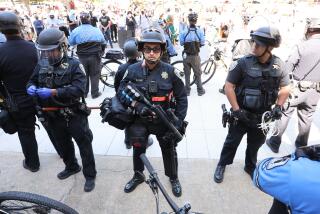Santa Cruz police chief took a knee during a George Floyd protest. Other police soon followed
- Share via
Santa Cruz Police Chief Andrew Mills knew he wanted to stand alongside his community on Saturday.
So when the moment came to recognize the death of George Floyd at the hands of a white Minneapolis police officer, Mills, who has served as chief for three years, had every intention of joining the protesters on Pacific Avenue.
“I had already determined in my mind that it was the right thing to do,” Mills said in an interview Monday. He wanted to send a message not only to the community but to his department “that people understand, in a very visual way, that we are with the community and part of the community.”
In a photo captured by a local photojournalist, Mayor Justin Cummings, the first black man to serve in the position, and Mills are side by side, down on their right knees, surrounded by protesters carrying signs and nearly all wearing face coverings or masks. Mills wears his police uniform, no riot gear in sight.
Floyd died in Minneapolis police custody last week, triggering protests in cities nationwide. While law enforcement officers have ramped up efforts to control those protests, some police chiefs and leaders condemned the action of the Minneapolis officers and offered gestures of peace with their communities.
In New Jersey, a police chief joined protesters in a march and held part of a sign that read, “Standing in solidarity.” A county sheriff in Michigan made it a point to take off his riot gear and walk with protesters. Houston’s police chief was pictured embracing a protester during a march.
In Oakland on Sunday, a video captured a group of local police officers who knelt as Mills did a day earlier.
On Friday, Mills penned a message about the killing, calling the actions of the Minneapolis officers involved “the antithesis of what we view as good policing.”
“The other officers had a duty to step in and stop this violent assault,” he wrote, “and they failed.”
The next day, he took a knee during a protest organized by community members that recognized Floyd’s death. This has become a symbolic gesture ever since NFL quarterback Colin Kaepernick started kneeling during the national anthem to honor black people killed by police brutality.
“I know that Colin’s decision to take a knee, and many others who knelt with him, was controversial,” Mills said. “As a police chief and a police officer for over 40 years … it did cause me to pause and stop and think about the communities of colors that we police with and try to understand. Which I cannot completely understand as a privileged 63-year-old white guy.”
“Taking a knee in this particular circumstance,” he continued, “I certainly understand the symbolism.”
Santa Cruz’s economy is built around seasonal tourism and the UC Santa Cruz. Businesses are starting to reopen, but staying safe depends on how the county can manage an influx of visitors.
Santa Cruz Sentinel photojournalist Shmuel Thaler was covering the protest Saturday morning, despite it being his day off. A staff photographer since 1987, Thaler said he kept an eye on the chief and looked for an opportunity to capture him near protesters.
The day passed peacefully, Thaler said, and on Saturday night, his photo started making the rounds online, joining the images and videos that showed moments of unity between protesters and law enforcement.
“I’ve seen comments that this is just PR, that it doesn’t mean anything, and I think it does mean something,” Thaler said. “It’s not solving the world’s problems, but we need to start somewhere, and we need to have people of courage do what’s not expected or normal, and I think this [photo] fits right into that.”
Cummings, who took office last year, said he has worked with Mills to improve policing, including regulating or prohibiting technology that has shown to be biased against people of color.
On the morning of Saturday’s protest, Cummings rode his bike to Pacific Avenue, where he spotted the chief and stopped to talk to him. When the time came to take a knee, Cummings found the chief beside him.
“For officers to acknowledge what happened and that being wrong, I think that is a really good first step,” Cummings said. “There’s obviously much more work to do, but it’s a good first step. And here in Santa Cruz, we’re continually trying to do better.”
Mills said he knew not all police officers would agree with his decision to kneel. “I don’t care,” he noted.
He said he will do whatever he can to press for change, not just in policing but in reducing incarceration and addressing bias in the court system for “systemic change” at the local, state and federal level.
“It’s shallow symbolism,” he said of the kneeling. “Now we have to put the structure, the policy, the change of heart, behind it.”
More to Read
Sign up for Essential California
The most important California stories and recommendations in your inbox every morning.
You may occasionally receive promotional content from the Los Angeles Times.












